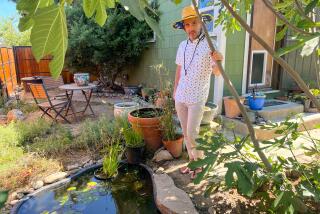Fish farm could soon revive empty greenhouse on Central Coast
- Share via
Corralitos, Calif. — Greenhouses once ruled the Pajaro Valley on the Central California coast, where the local cut-flower business found success worldwide.
Empty nurseries now dot the area, a sign of the industry’s decline. But with the help of plenty of water, Chris Newman, 58, hopes to restore the glory of greenhouses.
His tactic is called aquaponics, a combination of aquaculture — fish farming — and hydroponics — growing plants in water. With the help of neighbors and his brother Tom, Newman has converted 14,000 square feet in a former rose-growing facility into a system of stream channels, gravel beds and water pipes where he hopes to soon raise fish and grow vegetables commercially.
“I’m pushing the envelope here, but I think this is something that’s bound to take off,” said Newman, who grew up in the Pajaro Valley, leaving only to launch a brief but successful career writing mystery novels in New York.
In recent decades, aquaponics has become an increasingly popular backyard pursuit, though its commercial application has been limited.
Just a few aquaponics businesses currently operate in the country, said Rebecca Nelson, editor of Wisconsin-based Aquaponics Journal. But the number is on track to grow.
“Farmed fish is really where we’re going as far as what we’ll have access to,” she said.
Aquaponics evolved from the desire to harvest fish rather than put stress on dwindling wild fisheries and grew to use the extra water for crops, Nelson said. The method’s toll on the environment, compared with other ways of farming fish and vegetables, is minimal.
“People here care about food ingredients and where they’re sourced,” Newman said. “Every 27-year-old kid in San Francisco now has a food blog.”
Newman, who has hired a marketing manager to develop his sales strategy, already has a name for his venture: Santa Cruz Aquaponics.
In his rented greenhouse, he’s dug 40-foot channels for fish such as catfish. Above those are two stories of gravel beds where vegetables will grow — initially watercress but perhaps others in the future.
The water will be pumped from the fish channels, where nitrogen and other plant-friendly nutrients accumulate, through the vegetable beds and then into an adjacent channel where duckweed will grow for fish food. Cleansed by the plants, the water then will flow back to the fish, closing a nearly self-sustaining loop.
Castings from worms in nearby bins, Newman says, will be added to the system to serve as an antibiotic for the fish and fertilizer for the plants.
Newman has already sunk nearly $100,000 into his venture, and he’s anxious to see a return.
“I know we’re going to do well,” he said. “And a lot of people here are rooting for us.”
Alexander writes for the Santa Cruz Sentinel.
More to Read
Inside the business of entertainment
The Wide Shot brings you news, analysis and insights on everything from streaming wars to production — and what it all means for the future.
You may occasionally receive promotional content from the Los Angeles Times.










